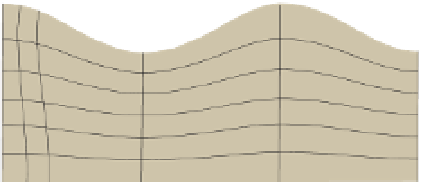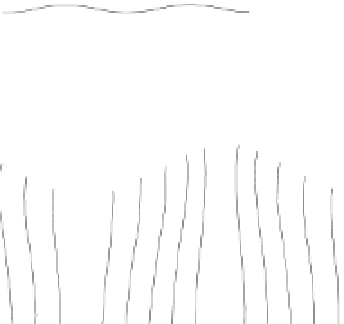Geoscience Reference
In-Depth Information
seismic surveys utilise P-waves, so they are the focus of our
description of the seismic method.
In the second kind of body wave, the strain associated
with the passage of the wave is a shear strain oriented
perpendicular to the direction of propagation with individ-
ual points oscillating in planes normal to the propagation
direction. These waves arrive after the primary waves and,
being secondary, are commonly known as S-waves. They
are also referred to as shear, rotational or transverse waves.
Since the propagation of S-waves involves a shear strain,
they cannot pass through fluids (liquids and gases).
waves (V
s
) are:
deformation involves shear strain, so these waves cannot
exist in a
fluid. The amplitude of Rayleigh waves decreases
exponentially with depth below the surface. In this respect
they are similar to water waves; a swimmer can easily dive
under the surf at the beach.
Rayleigh waves have complex, long-lived, multicycle and
continually changing forms, owing to the interference of
different frequency components travelling at different
velocities, referred to as dispersion. They generally have
larger amplitudes, more complex waveforms and longer
wavelengths than body waves. Considerable effort is made
during seismic surveying and data processing to reduce
this major source of noise. Although the velocities of
Rayleigh waves are frequency dependent, they are always
less than the velocity of S-waves, commonly around 90%.
r
ψ
ρ
V
P
¼
ð
6
:
3
Þ
and
6.3
Propagation of body waves through
the subsurface
r
μ
ρ
V
S
¼
ð
6
:
4
Þ
As the seismic wavelet travels through the subsurface, it
is changed by variations in elastic properties of the sub-
surface, which are related to changes in the geology.
To understand how it is changed we describe
firstly the
fundamental concepts of tracing the propagation path
using wavefronts and rays. This allows us to describe why
the amplitude of the wavelet changes with time, how the
direction of travel is changed and, most importantly, how
the wavelet can be split into different parts which travel
along different paths, allowing a single source to produce
many body wave arrivals at each detector.
The velocity of P-waves always exceeds that of S-waves.
S-wave velocity is usually around 70% of the P-wave
velocity.
6.2.3
Surface waves
The most important surface wave in seismic surveying is
the Rayleigh wave, informally called ground roll. During
the passage of a Rayleigh wave, the motion of a point
is elliptical in the plane containing the vertical and the
direction of wave propagation (
Fig. 6.3
). The associated
6.3.1
Wavefronts and rays
Propagation
direction
Seismic waves propagate away from their source, in a way
approximately analogous to the expanding circle of ripples
created when a stone is thrown into a pond. The ripples are
wavefronts, de
ned as the envelope of the locations that a
particular point on the seismic wavelet has reached at a
given time. The progress of the seismic wavelet through the
subsurface can be monitored by determining the shape and
location of the wavefronts at different times.
In the simple situation where the seismic source is
located at depth in a homogeneous material, i.e. one
through which seismic waves travel with the same velocity
in all directions, a body-wave wavefront will be spherical
and centred on the source. When the source is at the
surface a body-wave wavefront forms a hemisphere
(
Figs. 6.4a
and
b
)
. The radius of the sphere/hemisphere
Retrograde elliptical motion of a point
Figure 6.3
The deformation associated with the passage of a Rayleigh


















































Search WWH ::

Custom Search